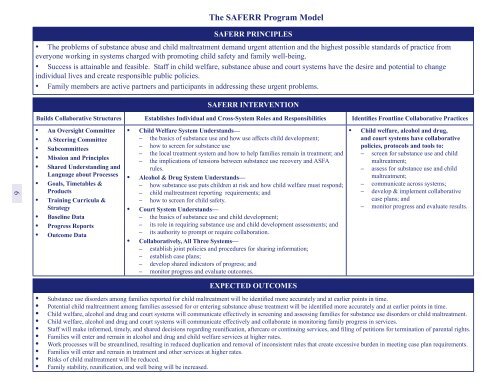Screening and Assessment for Family Engagement, Retention, and ...
Screening and Assessment for Family Engagement, Retention, and ...
Screening and Assessment for Family Engagement, Retention, and ...
Create successful ePaper yourself
Turn your PDF publications into a flip-book with our unique Google optimized e-Paper software.
6<br />
The SAFERR Program<br />
Model<br />
SAFERR PRINCIPLES<br />
• The problems of substance abuse <strong>and</strong> child maltreatment dem<strong>and</strong> urgent attention <strong>and</strong> the highest possible st<strong>and</strong>ards of practice from<br />
everyone working in systems charged with promoting child safety <strong>and</strong> family well-being.<br />
• Success is attainable <strong>and</strong> feasible. Staff in child welfare, substance abuse <strong>and</strong> court systems have the desire <strong>and</strong> potential to change<br />
individual lives <strong>and</strong> create responsible public policies.<br />
• <strong>Family</strong> members are active partners <strong>and</strong> participants in addressing these urgent problems.<br />
SAFERR INTERVENTION<br />
Builds Collaborative Structures Establishes Individual <strong>and</strong> Cross-System Roles <strong>and</strong> Responsibilities Identifies Frontline Collaborative Practices<br />
•<br />
•<br />
•<br />
•<br />
•<br />
•<br />
•<br />
•<br />
•<br />
•<br />
•<br />
•<br />
•<br />
•<br />
•<br />
•<br />
•<br />
•<br />
•<br />
•<br />
An Oversight Committee • Child Welfare System Underst<strong>and</strong>s— •<br />
A Steering Committee<br />
– the basics of substance use <strong>and</strong> how use affects child development;<br />
Subcommittees<br />
Mission <strong>and</strong> Principles<br />
Shared Underst<strong>and</strong>ing <strong>and</strong><br />
Language about Processes<br />
Goals, Timetables &<br />
Products<br />
•<br />
– how to screen <strong>for</strong> substance use<br />
– the local treatment system <strong>and</strong> how to help families remain in treatment; <strong>and</strong><br />
– the implications of tensions between substance use recovery <strong>and</strong> ASFA<br />
rules.<br />
Alcohol & Drug System Underst<strong>and</strong>s—<br />
– how substance use puts children at risk <strong>and</strong> how child welfare must respond;<br />
– child maltreatment reporting requirements; <strong>and</strong><br />
Training Curricula & – how to screen <strong>for</strong> child safety.<br />
Strategy • Court System Underst<strong>and</strong>s—<br />
Baseline Data – the basics of substance use <strong>and</strong> child development;<br />
Progress Reports<br />
– its role in requiring substance use <strong>and</strong> child development assessments; <strong>and</strong><br />
Outcome Data<br />
•<br />
– its authority to prompt or require collaboration.<br />
Collaboratively, All Three Systems—<br />
– establish joint policies <strong>and</strong> procedures <strong>for</strong> sharing in<strong>for</strong>mation;<br />
– establish case plans;<br />
– develop shared indicators of progress; <strong>and</strong><br />
– monitor progress <strong>and</strong> evaluate outcomes.<br />
EXPECTED OUTCOMES<br />
Child welfare, alcohol <strong>and</strong> drug,<br />
<strong>and</strong> court systems have collaborative<br />
policies, protocols <strong>and</strong> tools to:<br />
– screen <strong>for</strong> substance use <strong>and</strong> child<br />
maltreatment;<br />
– assess <strong>for</strong> substance use <strong>and</strong> child<br />
maltreatment;<br />
– communicate across systems;<br />
– develop & implement collaborative<br />
case plans; <strong>and</strong><br />
– monitor progress <strong>and</strong> evaluate results.<br />
Substance use disorders among families reported <strong>for</strong> child maltreatment will be identified more accurately <strong>and</strong> at earlier points in time.<br />
Potential child maltreatment among families assessed <strong>for</strong> or entering substance abuse treatment will be identified more accurately <strong>and</strong> at earlier points in time.<br />
Child welfare, alcohol <strong>and</strong> drug <strong>and</strong> court systems will communicate effectively in screening <strong>and</strong> assessing families <strong>for</strong> substance use disorders or child maltreatment.<br />
Child welfare, alcohol <strong>and</strong> drug <strong>and</strong> court systems will communicate effectively <strong>and</strong> collaborate in monitoring family progress in services.<br />
Staff will make in<strong>for</strong>med, timely, <strong>and</strong> shared decisions regarding reunification, aftercare or continuing services, <strong>and</strong> filing of petitions <strong>for</strong> termination of parental rights.<br />
Families will enter <strong>and</strong> remain in alcohol <strong>and</strong> drug <strong>and</strong> child welfare services at higher rates.<br />
Work processes will be streamlined, resulting in reduced duplication <strong>and</strong> removal of inconsistent rules that create excessive burden in meeting case plan requirements.<br />
Families will enter <strong>and</strong> remain in treatment <strong>and</strong> other services at higher rates.<br />
Risks of child maltreatment will be reduced.<br />
<strong>Family</strong> stability, reunification, <strong>and</strong> well being will be increased.


